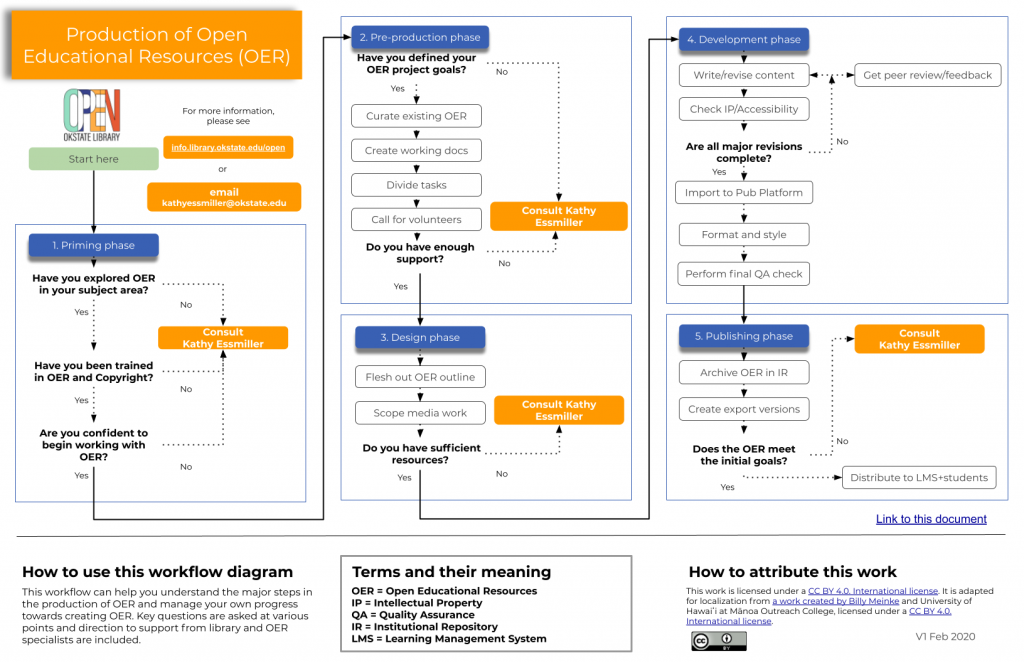Laying the Foundation: Preproduction
During the preproduction stage of your OER adaptation or creation project OSU Libraries can work with you and your team to lay the foundation for the customized design, development and publication of your resource. At the conclusion of of the preproduction phase, you will have defined your project, drafted and completed a Memorandum of Understanding, populated your author guide, and reviewed and curated a list of possible outside resources.
Define Project

The first step is determining whether you want to adopt, adapt, or create OER. Each of these options can take many forms, all of which begin with careful review and curation of existing resources. [insert read more]
You may find a resource you wish to adopt in its entirety, as is. If so, you then will determine whether you want your students to access the resource from the platform on which you found it, or if you would like to work with OSU Libraries to provide access through Canvas or OpenOKState.
You may find a resource you wish to adopt with minor customization. Perhaps you would like to modify the content somewhat, change the order of the chapters, or include images you think will increase its relevance to your students. You may also wish to combine portions of several resources, mashing together several different parts to make one whole.
You may discover you wish to substantially modify an existing resource, publish your course outside of Canvas, or create entirely new material. Although you can always change your mind about the degree to which you are creating new material, it is well to have clearly defined goals at the start of your project. Consider and determine early on whether you want to adopt, adapt, or create.
Memorandum of Understanding (MOU)
It’s hard to slow down for this one, but it is important to complete at the outset of your project. The MOU drafting process helps clarify goals, establish timelines, and articulate many easy to ignore details associated with OER modification and creation. In addition, a completed MOU clearly communicates copyright ownership over the created material, as well as the licensing under which it is intended for publication.
The OpenOKState MOU process is mutually negotiated between the corresponding authors and the OER Librarian. We will work together to modify the OpenOKState MOU Template to document and communicate the details of your project. Once these details are finalized, we will sign and file the completed MOU. As the project proceeds, it may be necessary to make changes to the timeline or the scope of the project; the MOU can be redrafted and modified to reflect these changes.
Author Guide
The preproduction stage will also include partial completion of the author guide. Portions completed at this point in the workflow will be those related to existing contributing authors, identification of the desire to recruit additional contributing authors, and determination if desired of an authors’ code of conduct. Although portions of the author guide relating to file types and submission deadlines may be populated at this point, sections regarding structure or content will be addressed during the design phase. Completion of any portion of the author guide is not required before moving forward through the OpenOKState workflow; we just want you to have it handy to help you think.
Possible Resources
You have a list of these, or you wouldn’t be here. As with any significant creative endeavor, systematic organization from the beginning helps eliminate frustration as the project progresses. With OER projects, intentional attention to licensing and permissions associated with found resources is of particular importance. Just as you tell your students to maintain a well-structured reference list so they aren’t underwater at the last minute trying to figure out what year a particular article was published, we encourage you to attend to permissions affiliated with each resource so you aren’t underwater at the last minute having found you want to re-mix a resource otherwise licensed.
We are happy to provide suggestions about how to track and curate your found resources (we are, after all, librarians). I suspect you already have a system which has worked for you in other projects; just make sure you note the level of permission along with each resource. If possible, include a link back to the original resource. If you aren’t certain of the licensing, we can help you. In fact, given a link to the resource as you found it, we can figure out the permissions pretty quickly. If the licensing and permission aren’t obvious to you, send the link to us and we will figure it out. We aren’t lawyers. But we will see what we can figure out.

